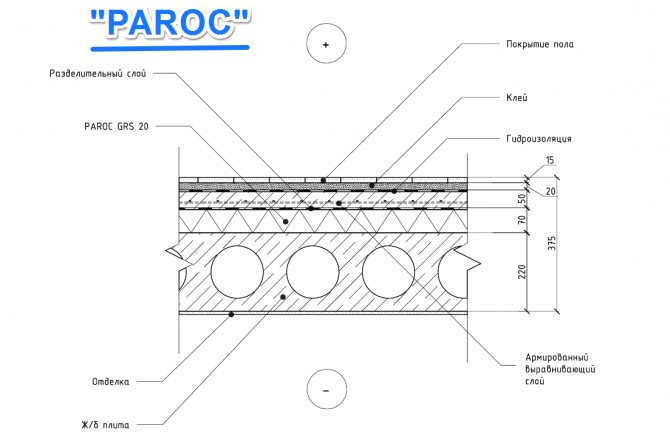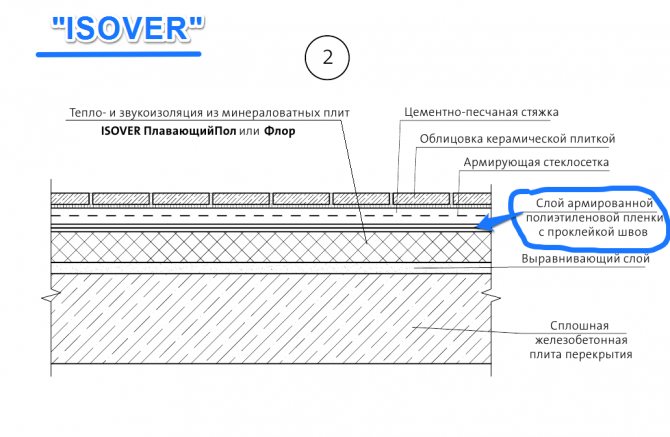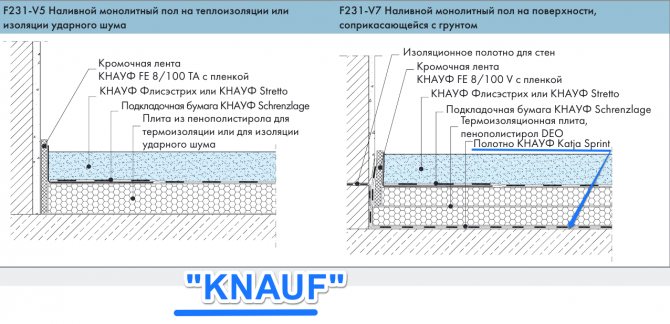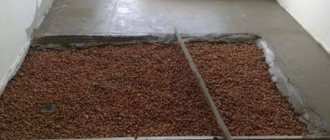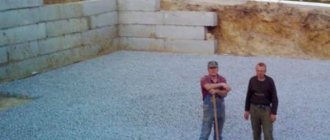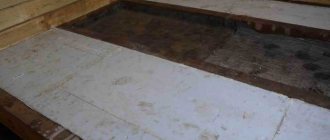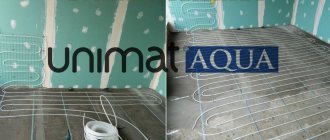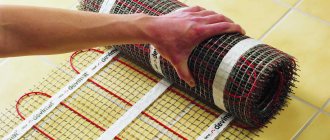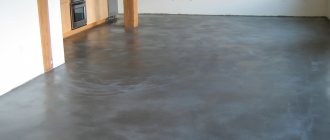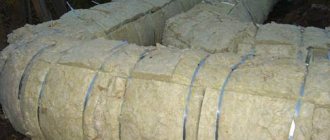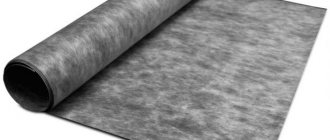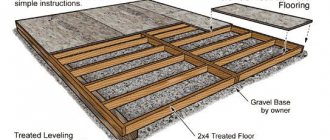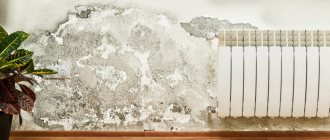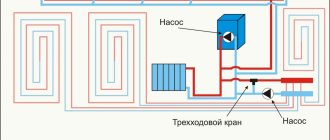Studying the technical characteristics of building materials, it is safe to say that expanded polystyrene is one of the best floor insulation. The cellular structure of the material has zero water absorption, which during operation retains positive working functions for a long time.
When organizing the insulation of the first floor with expanded polystyrene, it should be noted that its classification includes various samples.
Penoplex
The slabs are designed for warming foundations, basement floors on the ground and for the production of sandwich panels, which can subsequently be used independently as insulation. In the manufacture of Penoplex, a fire retardant is used, which effectively affects the increase in resistance to combustion and provides positive thermal dynamics of insulation. The price of one plate is from 100 rubles / piece.
Termite
The insulation is made by extrusion pressing, which makes the material a universal sound and waterproofing agent. It is used for insulating floors of loggias, balconies, foundations and basements. The service life is at least half a century, and the cost varies from 83 rubles / piece.
Technoplex
The material is used both as a heat-insulating material for floors and foundations, walls and roofs. The processing of the slabs is smooth, which creates an even surface. Technoplex has a low coefficient of thermal conductivity, which ensures reliable sealing against penetration of cold air currents. The cost of the material is from 150 rubles / sheet.
Stages of work
The contour insulation of the floor with extruded polystyrene foam is carried out on a flat base, taking into account the relative ability to compress. Installation work is carried out in several stages: waterproofing, insulation, mesh reinforcement, screed formation and finishing of the subfloor.
Waterproofing is carried out using a polyethylene film that covers the entire surface of the subfloor. Before you start laying the insulation, logs are mounted, the voids between which will be filled with plates. The gaps between the modules are filled with polyurethane foam to exclude the possibility of cold air bridges. The boards are glued with construction glue or cement mortar mixed with glue.
A reinforcing mesh with a screed is applied on top, which in the future will provide resistance to mechanical and forceful influences. The safety margin of expanded polystyrene is large enough to withstand medium distributed loads.
To ensure a more comfortable microclimate, the floors are supplied with electric heating, for the device of which expanded polystyrene is the most acceptable material, as it will competently provide maximum return and distribution of heat from heating cables. Thermal insulation with its use can significantly reduce the degree of radiation of thermal energy. Polystyrene is effective even in thin layers.
Comparing the thermal conductivity of polystyrene plates with other heaters, it is equivalent:
- Lumber 2 cm thick.
- 9 cm thick building brick masonry.
- Dry foam concrete 5 cm.
- Minplate 3 cm thick.
Expanded polystyrene is a gas-filled material obtained from polystyrene and styrene copolymers. The gas-filled styrene granules are dissolved in the polymer mass, then the mass is heated with steam, as a result of which the initial granules multiply in volume. The granules occupy a block shape and are sintered together. This technology is used to produce expanded polystyrene.
Natural gas is used for standard styrofoam.For fire-resistant - carbon dioxide. Expanded polystyrene is an inexpensive building material that does not require special knowledge and special equipment to work with it. The material is used mainly as thermal insulation and less often as decorative elements.
Is it worth using polystyrene foam as insulation?
Expanded polystyrene is a gas-filled material that is obtained from polystyrene and its derivatives, as well as from styrene copolymers
Building materials of the expanded polystyrene group are ideal for arranging a warm floor using the technology. They are able to cope with two problems at the same time: they do not allow moisture and steam to pass through and provide good thermal insulation.
Polyfoam, like its extruded variety, does not absorb soil moisture.
One square meter of such material is able to withstand a significant load without collapsing.
This type of insulation is well combined with water and electrical equipment of the "warm floor" systems.
Most heaters change under the influence of high temperatures, swell from moisture. Expanded polystyrene under the same conditions does not change either geometric parameters or structure.
This material has excellent resistance to negative biological or chemical factors.
Installation is simple enough to carry out. When arranging small segments, the slabs are very easy to cut as needed; with expanded polystyrene, it is possible to carry out insulation with your own hands in any room of configuration. Another plus is a rather pleasant, affordable price. It is quite accessible to almost anyone who wants to make repairs in the house and carry out floor insulation with expanded polystyrene.
Insulation with building materials of this class belongs to those schemes that are designed for a long service life. If you calculate how much after such a procedure the costs of heating your home are reduced and compare the result with the cost of work, it will definitely not seem excessive.
Scope of application of expanded polystyrene
Depending on the density of the material, expanded polystyrene is used in the following areas:
- As unloaded thermal insulation
slabs with a density of up to 15.0 kg / m3 used in enclosing structures such as: floors, internal partitions, pitched roofs, attic floors, insulation of balconies, containers, etc. - For loadable thermal insulation
slabs with a density of 15.1 to 25.0 kg / m3 used in the production of sandwich panels and in, floors, rabbits, three-layer walls with a protective and decorative layer of brick. - Any facade brands of slabs with a density of 16 to 20 kg / cubic meter. used for thermal insulation of vertical enclosing structures
various facade thermal insulation systems with external plaster layers. - Plates with a density of 25.1 to 25.0 kg / m3 used in structures with significant loads - Self-leveling floors
in civil and industrial construction, insulation of foundations, walls in basements. And also in the manufacture of packaging products. - Plates with a density of 35.1 to 50.0 kg / m3 are used as thermal insulation for surfaces that are particularly loaded during operation. - basement floors, zero cycles of buildings, garages and parking lots, in the construction of floors and roofs used for automobile and pedestrian loads, etc.
The consumer must know all the properties of the thermal insulation material in order to make the best decision for himself. Consider the pros and cons of expanded polystyrene.
Advantages and disadvantages of expanded polystyrene
TO positive
the qualities of the material include the following points:
The advantages of the material include such qualities as sound insulation, moisture resistance, low price and durability of the material (more than 50 years).
Negative
the qualities of this insulation are much less:
- Deformation
... Low heat resistance allows the development of thermal deformation at a temperature of + 80-90 degrees. - Flammability
... Gas-filled expanded polystyrene granules are capable of igniting at very high temperatures. - The need for protection
from mechanical damage
Having familiarized yourself with the basic properties of the material and opting for polystyrene foam, you can use the options below. Warm floors are an integral part of an energy-efficient home. Floor insulation with expanded polystyrene under the screed will help reduce heat loss
and will make the temperature in the room comfortable and cozy.
Insulation with expanded polystyrene is an affordable and simple way of thermal insulation.
Insulation of the floor with expanded polystyrene (polystyrene): a guide for work
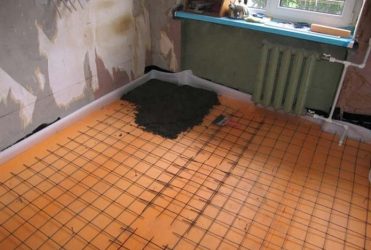
Floor insulation is an obvious necessity. It is justified by economic calculations and the desire to provide favorable microclimatic conditions, both in apartments of multi-storey buildings and in autonomous low-rise buildings. Insulation of ceilings will reduce heat loss, eliminate the causes of a number of diseases associated with hypothermia. They increase the thermal performance of the walls with the help of different materials and laying schemes, among which the insulation of the floor with expanded polystyrene is not the last place.
Insulation technology with expanded polystyrene
Insulation of a concrete floor using expanded polystyrene granules
Adding granules to the concrete solution allows the concrete floor to acquire thermal insulation properties.
To do this, mix the concrete solution. Add dry cement to a small amount of water and stir with a drill with a special nozzle until the consistency of sour cream. Without stopping to interfere, polystyrene granules are added to the solution. This can be the ratio of concrete to granules as 1: 3 and 1: 6. Than
the more filler, the warmer the floor
... Depending on what hard floor covering the concrete-expanded polystyrene screed will then be covered, the ratio is determined. The more granules, the lower the strength. Also, the screed with granules has a soundproofing quality.
Insulation of floors with expanded polystyrene sheets under a concrete screed
To begin with, the soil is compacted, crushed stone is poured and a layer of sand and a film are covered on top. Then the sheets of material are laid tightly around the entire perimeter of the floor. The joints are filled with polyurethane foam or glued. Lay another layer of film. To protect sheets from mechanical stress
to which the floors are exposed must be laid on the sheets
durable mounting mesh
... Pour the surface with a 40-60 mm thick screed mortar. When the solution hardens, the floor covering is laid.
Insulation of floors on logs
If the floor is made using a log, then it becomes much easier to insulate the floors. To begin with, wooden floor elements are processed antifungal drugs
and moisture protection agents. Then, boards or sheets of chipboard are attached to the self-tapping screws from the lower side of the lags, and sheets of material cut to the size of the opening are laid on them. From above, the covering is covered with foil and floor covering.
Installation of expanded polystyrene on a ground base
This option is great for homeowners.
Floor erection from the ground level requires the following works:
- Careful leveling and compaction of the soil is carried out.
- Crushed stone is poured onto the ground and leveled. The layer thickness should be within 10 cm.
- A small layer of sand is poured on top of the crushed stone, which will serve as a kind of pillow. The layer is carefully leveled and tamped.
- After that, sheets of expanded polystyrene are mounted on a sand cushion. The sheets should be stacked as tightly as possible. If you need to trim sheets to size, then this operation is performed as accurately and accurately as possible.
- A layer of vapor barrier is laid on top of the insulation layer.The film is laid in half a sheet and fixed with tape.
- For greater strength and durability, a layer of reinforcement is laid before pouring.
- The next stage is filling the floor with cement-sand mortar. The surface is carefully leveled and smoothed with a float. The screed should be calculated in such a way that the concrete thickness is within 5 cm, which will provide the floor with the required strength.
- After the screed has set, the base is finally leveled, after which the floor covering can be laid.
How to avoid common mistakes
To work with polystyrene foam is of high quality, avoid the following mistakes.
- Special attention to the base / plinth rail
... If horizontal cracks suddenly appear on the plaster, then the plinth rail was not fixed correctly. To correct the errors, you need to remove 10 cm of plaster from the bottom edge and cut off part of the insulation that covers the rail. Fasten the rail and cover it with a net to the bottom edge. Then the new mesh is overlapped by 10 cm with the old one and covered with fresh plaster. - Contact of polystyrene foam with the ground
... When expanded polystyrene comes into contact with the ground, the material quickly gets wet and becomes unusable. Here, a plinth strip is needed, which performs a protective function. To correct the error, you need to cut off the bottom edge of the insulation and replace it with extruded polystyrene foam. - When using three-layer enclosing structures, in which the outer and inner walls are made of small blocks or bricks, polystyrene foam should not be used. In this case, mineral wool in slabs is more suitable. Also do not use expanded polystyrene as insulation for wooden houses
... The material traps the release of water vapor to the outside, thereby causing wood to rot. - Weather conditions are very important.
in the work on insulation. Work should be carried out in dry weather at temperatures from + 5 to + 25 degrees. - Failure to comply with the thickness of the insulation
... If too thin a slab layer is applied to walls made of concrete hollow blocks or large slabs, the buildings will still be cold. - The emergence of thermal bridges
... When used in fixing the plates with dowels of an unsuitable quality (in the future, the supporting discs disappear), thermal bridges arise, which contribute to intense heat leakage.
Whatever insulation you would use, we can say with confidence that after installing thermal insulation, the house will become warmer, and the atmosphere in it will be pleasant for residents.
Video of floor insulation with expanded polystyrene
Surprisingly, extruded polystyrene foam (XPS) was developed more than 70 years ago, but its widespread use in construction has only developed in recent decades.
Plates made of this material are used for thermal insulation. With their help, facades, roofs, ceilings are insulated, floors are made of extruded polystyrene foam.
Before we start insulating floors with extruded polystyrene foam, let's find out what kind of material it is. It can be called a "relative" of polystyrene, the differences in their structure are hidden in the production technology. XPS has a uniform pore structure with a mesh diameter of less than 0.2 mm. It is denser, has minimal moisture absorption, but the same property is responsible for its poor vapor permeability. The disadvantage is its flammability, which manufacturers of conventional foam avoid using special additives. On the plus side, the expanded polystyrene used for floor or wall insulation will last about 40 years. As for the fastening material, it is best to use.
How to independently insulate the floor with expanded polystyrene
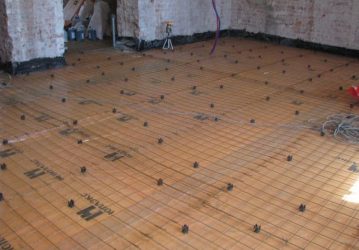

Given the constant rise in prices for electricity, gas and coal, proper thermal insulation of premises is becoming in demand, allowing significant savings in heating and additional comfort to be achieved. It is the insulation of the floor with foam that is the solution to which they return after a long review of materials that are suitable in price and characteristics.
Extruded polystyrene foam flooring
Creation of an insulating layer of extruded polystyrene foam significantly reduces the cost of construction and repairs. As a floor insulation, extruded polystyrene foam is very good. It can withstand tougher loads than polystyrene and has greater thermal performance at a lower thickness. The use of extruded polystyrene foam for the floor is encouraged when arranging the first floors, where it is important to prevent moisture from penetrating from the basement or from the ground. The features of this material are such that when using it for laying the floor, there is no need for additional waterproofing. With its help, you can even arrange floors directly on the ground - however, in this case, you cannot do without waterproofing. So, extruded polystyrene foam is excellent for the garage floor. Extruded polystyrene foam is irreplaceable for underfloor heating, since it is fully compatible with the necessary electrical and water systems. In this case, the thermal insulation plates also act as a reflection screen, allowing you to avoid additional waste of electricity and heat only the floor, and not the neighboring ceiling under it.
Recommendations for floor insulation with extruded polystyrene foam
- The installation of a floor with extruded polystyrene foam requires a certain preparation of the surface: it must be clean, dry and even. If necessary, use a cement screed.
- The plates should be joined as tightly as possible. As a rule, special grooves have already been made in them to ensure reliable alignment.
- When the floors are made of extruded polystyrene foam, thermoacoustic tape is usually laid along the walls.
- When insulating floors, waterproofing is also placed on the XPS boards - usually it is a plastic film that is laid with an overlap, and its edges are bent by about 6 cm.
- Further, the device of the floor with expanded polystyrene continues with a cement screed, the thickness of which must be at least 5 cm.
- If a wooden floor is insulated with extruded polystyrene foam, then instead of a cement screed, the coating is immediately laid.
Floor insulation when laying on the ground


Floor insulation when laying on the ground
The technology differs from the device of a floor on a concrete base only in that the soil must be pre-prepared, layers are laid before installing the insulation.
- the base is leveled and compacted.
- backfilling of a 10-cm layer of crushed stone.
- to fill the voids of the previous layer, a layer of fine sand is compacted on top.
The next stage is the laying of extruded polystyrene foam.
Heaters based on polystyrene do an excellent job with their main task. You can also insulate the floor with expanded polystyrene with your own hands - even a person who does not have special construction skills is able to cope with this task quite easily. This method is not only quite democratic in terms of cost, but also significantly increases the thermal performance.
How to choose polystyrene foam for floor insulation
When you need extruded polystyrene foam for your flooring, you will find that there is a wide variety of products. The thickness of the slabs can be either 20 or 100 mm. In addition, they have different technical characteristics such as compressive strength and thermal conductivity. Proceed from what load you put on your floors - so, for a garage floor, the insulation should have much greater strength than for a living room or a loggia, where there are enough slabs with a density of 30-35 kg / m3.The degree of insulation depends on the thickness of the material. Plates for underfloor heating can be thinner, but if heating is not provided, then extruded polystyrene foam for laying a floor, wood or laminate, is better to take thicker. Take into account the flammability class, which can also be different. Plates also differ in the shape of the joint: it can be a step, a thorn-groove, a smooth joint.
For extruded polystyrene foam for the floor, the price depends primarily on the density: for example, a square meter of heat-insulating floor boards with the same thickness of 50 mm can cost either 200 rubles or 260 rubles. Prices for a cubic meter for XPS of different brands differ by 10 -15%: for example, Tepleks offers expanded polystyrene with a density of 35 kg / m2 suitable for flooring. cub. at a price of 3800 rubles. per cube, Primaplex - 4200 rubles, and Technonikol - 4300 rubles. per cubic meter.
Insulating floors with extruded polystyrene foam is a great way to save energy. Indeed, through cold floors, the room can lose up to 20% of the heat. It would be correct to take this into account even during construction. However, it is never too late to insulate your home, and modern building material is the first assistant in this.
Heating costs directly depend on the high-quality thermal insulation of the structural elements of the building. Particular attention should be paid to the thermal protection of the floor, through the surface of which up to 20% of heat is lost. Modern building technologies offer a good and affordable option for thermal insulation - floor insulation with expanded polystyrene.
Expanded polystyrene insulation has a uniform closed-cell structure, which includes polystyrene microgranules filled with carbon dioxide. The most famous polystyrene materials, which have the same chemical composition, but differ in the production method, are polystyrene and extruded polystyrene foam. The first of them is obtained by exposing polystyrene granules to water vapor, and the other by extrusion. The result is transparent or colored sheets.
Which one is more suitable for protecting against floor heat loss? Thermal insulation of the floor using extruded polystyrene foam, which has a high density, is somewhat more expensive, but much more effective. Expanded polystyrene for the floor has excellent heat-saving and sound-absorbing properties. It practically does not absorb moisture, is fire resistant and environmentally friendly. The leaders among sales are heaters of the following brands: Penoplex, TechnoNIKOL XPS, URSA XPS, Primaplex.
Floor insulation with styrodur (extruded polystyrene foam)
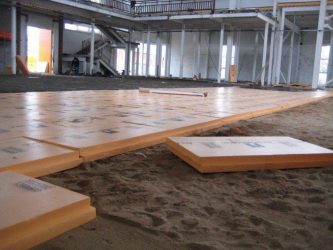

The floor can be insulated with various materials. The most popular ones are:
Extruded polystyrene foam, which will be discussed in this article, is just one type of insulation. In some ways he is better than everyone else, in some ways he is worse, in some respects he is “on an equal footing”.
The main advantages of expanded polystyrene as insulation are:
- Non-toxic, environmental friendliness of the material.
- Low hygroscopicity, i.e. little moisture absorption.
- Low specific weight, which makes it easy to transport and install.
- Good sound insulation properties.
- Resistance to chemicals and microorganisms.
- High strength in comparison with some other insulation materials (for example, against the background of mineral wool).
- Long service life (at least 15 years).
- Resistant to vapor diffusion.
- Ease of processing. Expanded polystyrene can be sawn, drilled, milled.
- Safety for human health and the environment.
All these advantages have made extruded polystyrene foam a popular insulation. Most often it is used to insulate building facades. This is due to the fact that this material has one big drawback - high flammability.Unlike stone wool or glass wool, expanded polystyrene is fire hazardous, therefore, it is not used to insulate walls inside a room.
What about floors? For them, expanded polystyrene is suitable, because it is still separated from the room by a concrete screed. Therefore, in the event of a fire, the fire is unlikely to reach the insulation.
Floor insulation technology with styrodur
By the way, the second ("unofficial") name of extruded polystyrene foam is styrodur. Thermal insulation technology consists of several stages:
- Laying a waterproofing film on the subfloor (this can be reinforced concrete floor slabs or a concrete screed).
- Bonding of expanded polystyrene boards using special assembly glue.
- Bonding joints between insulation plates with polyurethane foam. This will prevent cold bridges from forming.
- Laying the mounting mesh on top of the insulation. This is done in order to evenly distribute the load over the extruded polystyrene foam, as well as to avoid possible deformations. Then a screed 40-60 mm thick is poured over the mesh.
When insulating with extruded polystyrene foam, only environmentally friendly materials are used. These include assembly glue, foam, mesh, and screed. All of these materials are resistant to mold or mildew, resist the activity of microorganisms and are inedible to rodents. Due to the combination of all these factors, the service life of the entire insulation system reaches 70-80 years.
By the way, styrodur can be mounted not only on the subfloor, but also on the ground. In this case, first you need to carefully prepare the base, lay a "pillow" of rubble and sand, cover it with a waterproofing film. Then the styrodur plates are mounted on glue.
5 advantages of expanded polystyrene as floor insulation
Styrodur has several strengths that make it stand out from other floor heaters:
- It protects the floor from cold and heat leakage 365 days a year.
- Heat loss is reduced by 45%.
- Completely inedible for insects and worms.
- It can be used in conjunction with water and electric floor heating systems.
- Long service life.
Finally, the price of extruded polystyrene foam is also very favorable. Considering the crazy tariffs for utilities in Ukraine, it will help everyone to save at least 20-25% on heating. In the summer, you will not have to cool the room either, because expanded polystyrene, which has cooled over the winter, will give coolness to the floor for a long time.
The most important thing is that the technology of floor insulation with extruded polystyrene foam (styrodur) is performed correctly.
Which manufacturer to choose
On the website of the Trivita online store you will find the best styrodur manufacturers:
- Eastplex.
- Ecoboard.
- Technoplex (Technonikol).
- Bateplex.
Order extruded polystyrene foam for floor insulation with delivery throughout Ukraine by phone:
- 067-549-59-52
- 050-549-59-52
- 093-549-59-52
- 044-466-59-52
The use of expanded polystyrene for thermal insulation of wooden floors
Thermal insulation of a wooden floor on logs with extruded polystyrene foam includes the following measures:
- Dismantling skirting boards and existing flooring;
- Inspection of the elements of the wooden system, repair and replacement, if necessary, of rotten parts of the support bar, log and rough flooring;
- Impregnation with fire retardant and antibacterial solutions of all areas of wood;
- Installation of a waterproofing layer. A polyethylene or foil film is placed between the logs, while the edges should go to the ends of the log and the side surface of the walls by 10 - 15 cm.
- Plates of expanded polystyrene make an insulating layer between the logs on top of the rough flooring, connecting them to each other with grooved ends. Gaps and slots are filled with polyurethane foam or special glue with pieces of expanded polystyrene;
- The device of a vapor barrier layer.Cloths of a profiled membrane or a dense polyethylene film are laid with an overlap, the size of which is 15 - 20 cm, and fixed to the logs with construction tape. Seams and edges are glued with special adhesive tape.
- Re-assembly in a wooden house of a boardwalk, the floorboard of which is pre-impregnated with a fire retardant and antiseptic compound.
Insulation of the floor along the logs can also be performed with a cheaper material - polystyrene, since the main load in this case will fall on the wooden structural elements.
Floor insulation with logs
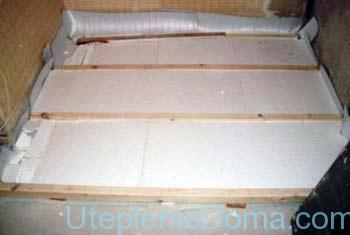

The process of insulating the floor with expanded polystyrene with lags
When laying cut sheets of foam plastic between the logs, PSB-S 15 is also suitable, since the logs will generally take on the load. For the device of thermal insulation on the first floor, the power standard is 10 cm, for floors between floors, 5 cm is enough.
Advice. If you use fiberglass URSA insulation to fill the gaps between the lags and the foam, the technological gap along the perimeter along the walls, it will be cheaper than polyurethane foam.
Technological method for protecting a concrete floor with expanded polystyrene
In brick and monolithic houses, floor insulation with extruded polystyrene foam is carried out under the screed. In this case, the insulation cake scheme is arranged as follows:
- Carry out the dismantling of the skirting boards, existing coating and screed to concrete floor slabs.
- The overlap is cleaned of construction debris and dirt. Then they are leveled with a cement-sandy composition and impregnated with a deep penetration primer.
- A waterproofing layer is made of roofing material, glassine, polyethylene or foil film.
- Plates of extruded polystyrene foam, the thickness of which is not less than 5 cm, are laid tightly to each other on top of the waterproofing layer. Gaps and voids between the plates are filled with polyurethane foam or special glue with pieces of insulation.
- A damper tape is laid along the perimeter of the room at the bottom of the wall.
- Expanded polystyrene insulation from above is covered with a vapor barrier membrane material, carefully sealing all seams and edges.
- A reinforced mesh is mounted and a concrete and cement screed is poured, the thickness of which is at least 5 - 7 cm.
On the screed, you can make a new flooring from boards or chipboard boards and decorate with any decorative coating.
Installation of underfloor heating on the ground floors of apartment buildings or private houses
Thermal insulation of concrete floors can be performed by laying a "warm floor" system with a water or electric heat carrier. The use in this case of expanded polystyrene for insulation is associated with the prevention of heat leakage into the base of the floor. In this case, the insulation cake looks like this:
- Dismantling the old floor structure and cleaning up debris and dirt.
- Leveling, filling chips, potholes and voids with cement mortar.
- Coating concrete floor slabs with hot bitumen in 2 times.
- Expanded polystyrene for floor insulation in the form of a slab is mounted on hot bitumen or special glue, pressing tightly together. Seams and gaps are filled with polystyrene foam.
- Laying around the perimeter of the room at the bottom of the walls with damper tape.
- Installation of reinforcing mesh on special supports.
- Layout of water pipes in rows, the distance between which is 10 - 30 cm and from the walls 10 - 15 cm and fixing them on clamps or clips. In the case of an electric coolant, a self-heating cable or electric mats are installed.
- The laid coolant is covered with another layer of reinforcing mesh.
- Filling of floor areas, separated by a damper tape, with cement or concrete mixture with a thickness of 5 - 8 cm.
Heat insulation on a concrete base on a screed
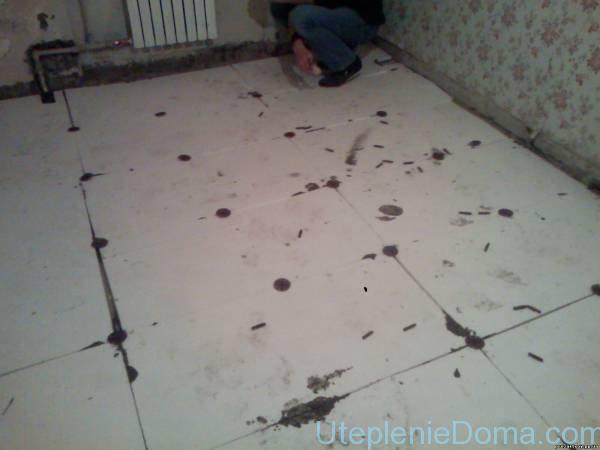

The process of warming a concrete floor polystyrene foam
For insulation of a concrete floor using foam, materials are selected according to the technology with a high quality of strength. Before installing the floor, you should perform the screed. After that, the layers are stacked in this order:
- waterproofing film;
- Styrofoam;
- reinforcing mesh - 2 cm of fastener solution is preliminarily applied to it;
- finishing screed - 5-8 cm;
- in conclusion, sealing is carried out along the perimeter of the technological gaps - using fiberglass or polyurethane foam.
Important. Rolled waterproofing should be overlapped on the adjacent strip - about 10 cm. Separate strips are reinforced with tape.
Subsequent work is carried out as usual - the floor covering is laid on the final screed, finishing, if necessary, plinth.
Thermal protection of the floor located above the ground
How to insulate the floor with expanded polystyrene in rooms located above a low subfloor? Floor insulation on the ground differs from other technologies in that the heat insulator is in direct contact with the ground. Therefore, special attention should be paid to the waterproofing device, since the earth is exposed to groundwater and melt water. The floors on the ground are insulated according to the following scheme:
- Dismantling skirting boards and old flooring.
- Leveling the soil with subsequent compaction.
- Arrangement of a crushed stone base with a thickness of 30 - 40 cm.
- Backfilling of a layer of sand and layer-by-layer compaction.
- Installation of reinforced mesh and pouring concrete screed.
- Laying a layer of waterproofing from dense polyethylene or foil.
- Lay the floor insulation on the ground. Expanded polystyrene is placed on the floor in a checkerboard pattern, eliminating the voids between them with polyurethane foam.
- Spreading overlapping sheets of waterproofing material, sealing the seams and edges with special tape.
- Arrangement of reinforced concrete screed with a thickness of at least 50 mm.
- Finishing floor layer of decorative finish.
The result will be better if you fill it with polystyrene concrete. Concrete with added polystyrene chips has an increased heat-shielding property.
Heat loss protection of concrete floors located above high subfloors
Insulation of a concrete floor with expanded polystyrene can be effectively performed from the side of an unheated room. This thermal insulation will keep the ceiling height in rooms above the basement. The underfloor is a room with high humidity, therefore, insulation work should be carried out with extruded polystyrene foam. This building material retains its heat-saving properties in a humid environment. When arranging an insulating cake from the basement side, you should:
- Clean the concrete base from dirt and wash.
- Smooth out voids, chips and potholes with cement mortar.
- Coat with deep penetration primer.
- Place the extruded polystyrene foam boards on the special glue and additionally fix them to the base with wide-headed dowels.
- Put a layer of waterproofing building material on top. A profiled membrane or foil can be used as waterproofing. Films should be overlapped, seams and edges should be sealed with reinforced tape.
- Lay the metal mesh and plaster.
The use of expanded polystyrene for floor insulation is an effective technology for thermal insulation and sound insulation for any structural features of buildings.
Warming the floor in the house is an important task in any repair, solving which the risk of colds is reduced.
Walking on a warm floor is much more comfortable.
Expanded polystyrene is a popular insulating building material, used mainly for insulating walls, ceilings and floors.
It is a gas-filled material that is extracted from polystyrene and derivatives, styrene copolymers.
The usual technology for its production involves the initial filling of styrene granules with gas, which dissolves in the polymer mass.
Expanded polystyrene, obtained by foaming a low-boiling liquid, is a material that consists of fine-cellular granules, sintered together.
It is curious to know that the granules contain micropores inside, and there are voids between the granules.
The higher the density of the material of the type in question, the higher the strength and the lower the water absorption, hygroscopicity and water resistance.
- high degree of compressive strength with low density;
- the ability to form complex shapes;
- environmental friendliness;
- ease of processing by means of an ordinary saw or knife;
- insignificant weight;
- the possibility of bonding with various surfaces and materials;
- non-toxic product;
- there is no smell;
- does not form dust;
- simplicity of mechanical fastening;
- ease of processing and installation of plates;
- fire resistant qualities;
- resistance to biological influences;
- low dynamic rigidity;
- excellent thermal qualities;
- low level of diffusion of water vapor;
- poor water absorption;
- lack of response to temperature changes;
- resistance to a number of chemicals.
The advantages of this building material can be listed for a long time, but this is not worth doing, because the list provided is enough to make the right choice.
When buying, it is worth taking into account the disadvantages of expanded polystyrene, which, although insignificant, for this material, however, still have:
- service life - 15 years;
- after 10 years of using the material for its intended purpose, it may deform, become unusable (if there is inappropriate installation);
- at the installation stage, the seams come out quite deep.
Epoxy self-leveling floor "Polyplast-EP"
Scope of application
Due to their high strength and durability, epoxy self-leveling floors are often chosen for protecting concrete foundations of production areas (mechanical engineering, metallurgical industry, etc.). They are also suitable for warehouse terminals with high loads. The polymer layer is not afraid of moisture, so such coatings can be used even for underground parking lots, car washes or service stations - where the air humidity is usually high. Due to the simple cleaning of the surface, such floors are often found in medical and administrative institutions - hospitals, clinics, laboratories.
Service life of the material "Polyplast-EP" after application to the surface - 15 years
Main parameters of the product
| A two-pack formulation based on a modified epoxy resin: consists of a paste (Part A) and a curing component (Part B) | |
| Surface characteristics | Free of inclusions, smooth surface with moderate gloss |
| After combining components (A and B), the ready-to-use composition retains its qualities at an air temperature of (20 ± 2) ° С, not less than min. | 40 |
| Time required to form a pavement at a temperature of (20 ± 2) ° С before pedestrian load | 1 day |
| Polymerization time at a temperature of (20 ± 2) ° С up to full chemical and mechanical load | 5 days |
Stages of creating a protective layer:
The application of our compound to a concrete screed can be divided into three stages:
1. Preliminary preparation of concrete for processing. In order for the polymer layer to reliably adhere to the base, its surface should be free from dust, grease or moisture. You also need to remove any damage to the screed - cracks, potholes, chips.
2. Application of the primer. To ensure high adhesion of the epoxy layer, we recommend first applying POLYPLAST Deep Penetration Primer to the substrate. This material also plays the role of additional waterproofing, sealing the pores of the screed. The product is applied in two layers.
3.Application of the filling system. After 5-24 hours from the moment the second layer of soil is applied, you can start laying the self-leveling floor. To do this, using the instructions for the composition, you need to mix parts A and B of the product "POLYPLAST-EP". To obtain a homogeneous composition, the mixture is stirred with a mixer for 10-15 minutes. When working, it is important to remember that after mixing, the composition retains its properties for no more than one hour.The product is applied to the substrate by pouring. Average consumption of the composition is 1.5-4.0 kg / m². When working, a squeegee (for even distribution) and a notched trowel are used.
Recommendations for use:
It is important to use a needle roller when pouring the top coat (as long as the material is still liquid). A uniform film is formed only if the composition fills the pores of the substrate. On a fresh (not formed) surface, employees move only in special shoes with needle soles.
Expiration date of the composition:
0.5 years
Precautions:
Do not work with the material near highly heated surfaces and devices due to the risk of fire. When applying, use personal protective equipment that protects the respiratory system and exposed areas of the body. It is equally important to ensure sufficient air exchange in the room (ventilation).
Storage and transportation requirements:
Self-leveling floor "Polyplast-EP" can be transported by any means of transport. For the preservation of the product, it is important to protect against moisture and avoid damage to the container. In the original packaging, the product can be stored at an air temperature of -30 ° C to + 30 ° C (direct sun is not allowed).
Equipment cleaning:
To clean the surfaces of equipment and tools after completion of work, use acetone, as well as solvents such as "R-5A" or "646".
Engineering works
Technical moments in floor insulation with expanded polystyrene deserve special attention.
Concrete base
In this video you will learn how you can insulate the floor with expanded polystyrene on the loggia.
Enjoy your viewing!
To insulate a concrete floor, careful preparation of the surface on which the material will be laid will be required.
Before starting work, it is worth knowing that the material must be of high quality and strength.
Layers:
- waterproofing film;
- expanded polystyrene;
- reinforcing mesh, on which you should first apply 2 centimeters of the solution;
- finishing screed with a thickness of 5 to 8 centimeters;
- sealing gaps around the perimeter of the room where the work was carried out (you can use foam or fiberglass for this).
It is important to remember: roll waterproofing should be applied with an overlap, which should be approximately 10 centimeters.
Floor insulation with extruded polystyrene foam
Extruded polystyrene foam is a heat-insulating material with closed cells, distributed among themselves.
The material does not shrink, besides, it does not rot over time, does not absorb moisture, is quite resistant to the effects of chemicals, does not swell.
Extruded polystyrene foam is characterized by high strength.
Laying technology:
- First, a layer of assembly glue is applied to the floor surface using a comb. The adhesive should be applied with gentle movements in a thin and even layer evenly over the entire area.
- The tiles are laid on glue, after which the material is pressed with hands to obtain better adhesion of surfaces.
- In this way, the laying of the entire remaining area of the room continues.
- The laid material is allowed to dry for a day, after which glue is applied to the plates.
- Next, a special cellular fiberglass is glued in, better known as serpyanka. This action should be performed to increase the degree of hardness and strength of the floors.
- The glue is leveled on the serpentine with a spatula.
- As a result, you will get a flat surface, on which the next day you can mount beacons and make a cement-sand screed.
Thermal insulation of the floor with extruded polystyrene foam
Below is a video instruction for those who want to insulate the walls of the house with expanded polystyrene.
An equally effective method of floor insulation is the use of modified polystyrene foam.
Thermal insulation of the first floor with this material provides for the installation of the material on floor slabs.
In this case, it is necessary to ensure that the joints do not coincide between the sheets with the joints of the floors.
The waterproofing is laid on top, after which a screed mixed from cement mortar is poured onto it.
The layers will look like this:
- Overlapping.
- A layer of plaster.
- Extruded polystyrene foam.
- Waterproofing layer.
- Cement strainer.
- Flooring.
Sequencing:
- The surface is prepared accordingly, significant irregularities are cleaned.
- Next, the insulation material is laid.
- Next, a waterproofing layer is laid.
- The surface is filled with a screed made of a cement-sand mixture, while the thickness of the screed should be within 30-50 centimeters.
- Next, the floor covering is mounted.
Wooden base
Often, wooden houses need to be laid with insulation material, which is often used as expanded polystyrene.
Work algorithm:
- In order to avoid subsequent subsidence, the soil is carefully compacted and leveled.
- After that, you need to fill up a layer of expanded clay.
- This is followed by laying the waterproofing.
- Then a layer of expanded polystyrene is made.
- Then a cement-sand screed is poured.
- The final stage is the flooring of the topcoat.
It is important to remember: wood is sensitive to high humidity, and therefore you need to carefully monitor the ventilation foundation channels.
Cement screed for insulation.
The need to make a screed for insulation arises in such cases:
- Warm floor.
- The floors are on the ground or on the insulated balcony, loggia.
- Significant thickness of the screed when leveling the floor in an apartment under one level.
- The need for additional sound insulation.
To do (in large quantities) such a screed has become relatively recent. Therefore, there are many fantasies and conjectures - the technology has not been fully developed.
Everything that will be said further is an attempt to understand the details of the insulation screed, and not give 100% technology.
Little time has passed for the accumulation of information about errors.
Which insulation is better?
Considering all the bedding made from expanded clay and vermiculite, as well as various additives to the solution, extruded polystyrene foam is the most popular insulation. Its strength is beyond doubt. We could have stopped at this option, but its price makes us look for alternatives.
Laying the other two insulation materials (stone wool and ordinary foam) on the floor, under the screed, causes concern for many. This comes from ignorance of the varieties (brands) of these materials. Crumpled pieces of Styrofoam underfoot and rock wool rolls intuitively suggest that they will look even worse under a layer of mortar. If you see clearly the strength of the insulation designed for this, then doubts disappear. The durability is impressive. For a screed in an apartment, this is more than enough:
The second panel (crushed by a wheel) is filled with mineral wool of low density, which is used as a heat-insulating layer in facade systems. Not to be confused with rock wool specimens intended for floating screed. You need to know, albeit superficially, the technological characteristics of the screed materials and your choice. This is so that later, not to look for the reason why the screed bends.
Every brand that produces thermal insulation has this type of insulation. Also, it can pass in the name, as a soundproofing material for the floor, under the screed:
- So at Termolife - these are plates "TL Pol" and "TL Pol-S".
- TechnoNIKOL has three types of such slabs: "Technoflor soil", "Technoflor standard" and "Technoflor prof". Each has its own purpose, its characteristics and cost.
- ROCKWOOL has FLOR BATTS, STEPROCK ND, STEPROCK HD boards.
- PAROC has a board "PAROC SSB 1" and "PAROC SSB 4".
All of these products have a high density. From 110 kg / m³ (PAROC SSB 1) to 160 kg / m³ (Stroprock). Another indicator is compressive strength at 10% deformation. This value is different, from 20 to 40 kPa (PAROC SSB 4).
If we compare the cost of replacing (on large layers) a cement screed with insulation, we get approximately the following price ratio for a conventional cubic meter of material:
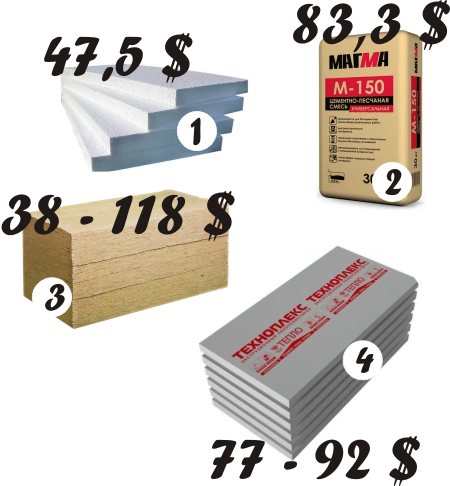

APPROXIMATE RATIO OF PRICES.
Replacing a partial layer of DSP screed (2) with a sheet of extruded polystyrene foam (4) will hardly affect costs. Or perhaps a slight increase in price. But taking into account all the factors - delivery, labor costs for lifting and laying, weight for overlap, insulation, the extruder wins by a slight margin.
Savings are only possible with ordinary foam (1). With basalt wool (3) it is impossible to say unequivocally. Significant price range.
The calculations are approximate and depend on the quality of the material, the delivery area, the specifics of the work in this area.
The thickness of the screed for insulation and whether a mesh is needed.
According to DIN (EU) building codes, the thickness of the screed on the separating layer (in our case, insulation) must be at least 35 mm.
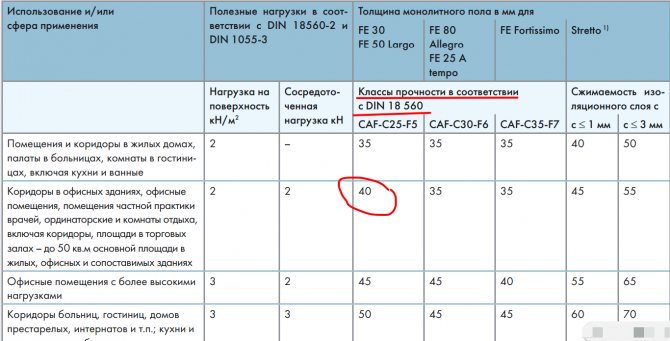

Screed thickness according to DIN standards.
All Knauf designs comply with this requirement. And the reinforcing mesh, as a prerequisite, is not provided:
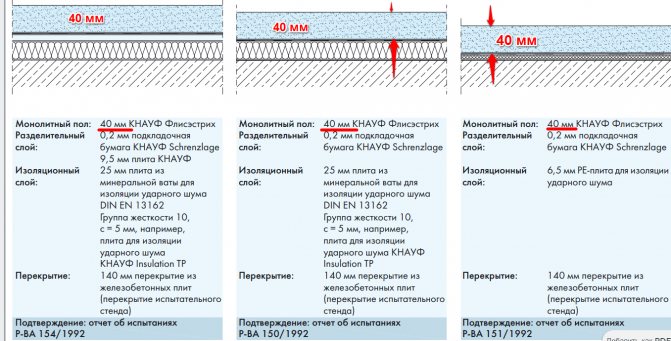

Only the lack of reinforcement raises concerns.
But if you look at it, using the example of an extruder screed (UZIN company - Great Britain), you can assume that this is possible:
What details can be noted:
- The solution is thick and moist. It does not look like a semi-dry screed solution. After leveling, the mixture squeezed water to the surface. This is the ideal moisture content for the screed mortar. Such a screed is devoid of the disadvantages of semi-dry, when a loose structure is formed at the base. At the same time, it does not crack, as is often the case with an ordinary wet one.
- The sand is coarse, which contributes to rapid shrinkage and squeezing out moisture to the surface.
- It is possible that additives (plasticizers) are used - water that is added to the mixer is cloudy, not natural in color.
- At the base is extruded polystyrene foam.
But, such conditions cannot always be sustained. Practice shows different results and therefore, there is a different opinion:
How to lay the reinforcing mesh, too, has a feature. You can do it like here:
If the mesh does not overlap, cracks appear along the joint. The screed in such cases does not work in one piece.
Perhaps this will not affect the installation of laminate or linoleum in any way. And it is possible that it will somehow be indicated when laying ceramic tiles (grout will crumble in separate seams). But this is guesswork. If you fix (photo, video) such changes on the tile, after laying the mesh in the screed without overlap, then you can draw conclusions.
Laying insulation under the screed.
With the installation of insulation, many fantasies also arise. Does it need to be fixed to the base? And how to fix it? Many people think that it is better to fix it - it will not get worse. And they are attached depending on the richness of imagination: on glue, on polyurethane foam with plastic dowels, just on sand or crushed stone.
An interesting solution from Knauf on this topic. Styrofoam sheets are placed on a bedding made of expanded clay and expanded clay sand. Backfill is such a thing, an invention of Knauf and has the name "Backfill for prefabricated floors".
The main thing to pay attention to in this process is the preparation of a bulk material base using an aluminum rule. The length of the tool and the presence of at least some level on it, allow you to get a good flat plane. This is necessary so that thin foam sheets do not break, and strong EPSPs do not sway:
The backfill can be replaced with sand, or even better, DSP. A mixture with cement is better because it pulls moisture from the screed and hardens. Well, just in case. The thickness of the leveling bed can be minimal, within a centimeter. Careful preparation of the base allows for the installation (with rubbing) without voids. Then it becomes possible to make a decision to make a screed with EPS without reinforcement.
Floor screed film.
There is also confusion with the film. Is it needed and where, on insulation or under insulation.
If we consider the working drawings of floating screeds from various manufacturers, then the separating layer of film is arranged only on top of the mineral wool slabs. Who calls it a vapor barrier, who is a film to protect the insulation from the flow of the solution.
And expanded polystyrene (Knauf recommendations) is covered with Schrenzlage lining paper. It is sulphate Kraft paper, coated on both sides with a film. It is not a waterproofing or vapor barrier and is installed under a monolithic self-leveling floor in accordance with DIN 18560-2.
Similar recommendations for shielding foam from cement mortar can be seen in some sources. The reason is supposedly the alkaline environment destroys it. How then to be with the insulation of all facades. When is a cement-based mixture applied to the exposed surface of expanded polystyrene?
One more detail. Knauf does not recommend the use of film due to the formation of wrinkles. Perhaps this is a marketing ploy - "nothing has been invented better than our backing paper." But the last video (at the end of the article), where folds appear on the plastic mesh when pouring the Weber-Vetonit mixture, is suggestive.
Similar solutions for the implementation of sound insulation from TechnoNIKOL and Ceresite:
What can be summed up:
- Ceresite allows the installation of a mineral wool screed without reinforcement, but using its own mixture "Ceresite CN 175". At the same time, the thickness of the screed (judging from the roller) is solid - the maximum allowable for this mixture is 60 mm.
- KNAUF has a similar solution.
- Weber-Vetonit has a similar soundproofing floor construction. Instead of a film - geotextile. The thickness of the self-leveling screed "Weber-Vetonit 4310" 15 - 25 mm, "Weber-Vetonit 4350" 25 - 30 mm. Additionally, reinforcement with WEBER R108 fiberglass mesh is performed.

